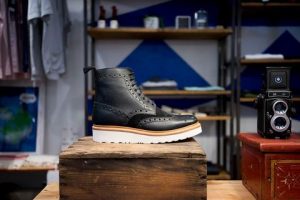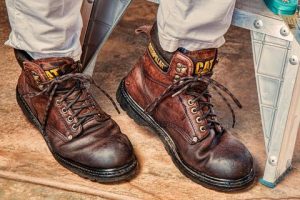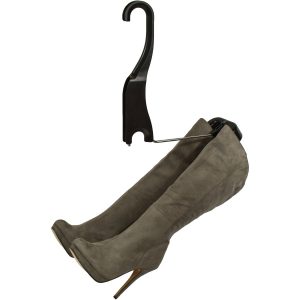 April showers bring May flowers. They also bring more showers! Spring and summer thunderstorms can be pretty fierce, leaving both you and your footwear soaked. And while you may not always remember to carry a spare umbrella around, there are steps you can take to ensure that whatever shoes or boots you’re wearing can withstand even the strongest of summer rains.
April showers bring May flowers. They also bring more showers! Spring and summer thunderstorms can be pretty fierce, leaving both you and your footwear soaked. And while you may not always remember to carry a spare umbrella around, there are steps you can take to ensure that whatever shoes or boots you’re wearing can withstand even the strongest of summer rains.
First things first: What are you using the shoes for?
If you regularly spend time in conditions where your shoes or boots will be getting rained on or muddy, chances are that the finished look is not as important to you as the protective layer being as strong as possible. So if, for example, you’re looking for waterproof boots that you regularly muck out stables in, that’s one thing. If, on the other hand, you’ve got a brand new pair of fabulous flats made out of supple Italian leather, we’re going to treat those differently as we need to be careful that the product you use doesn’t discolor the leather.
SECOND: Understand The Process.
What you’re going to be doing is applying a barrier against water, ice, snow, and mud. That barrier will need to be applied to a clean shoe, first and foremost. So grab a clean cotton rag or shoe brush, and get to work.
THIRD: Shampoo First, Then Condition.
Remove any visible mud and dirt, and then get down to the details. Different materials require different cleaning methods, and we’ve got you covered here:
SUEDE is quite delicate and requires different care than other types of leathers. Visit How to Clean, Protect, Wear & Store Suede for a deep dive into suede care.
For all different types of STAINS, check out Stains On Leather: Get Rid Of Them and Get Your Leather Looking Like New Again. DISTRESSED LEATHER is unique, so head over to How To Take Care Of Your Distressed Leather Cowboy Boots.
 Finally, we also put together a post on FINISHED LEATHER, which is the most common type of leather:
Finally, we also put together a post on FINISHED LEATHER, which is the most common type of leather:
Expert Leather Care for Your Boots. If you’re working with a pair of new shoes, give them a wipe with a clean cloth to make sure there’s no dust on the surface. If you’re working with a pair of shoes/boots that you’ve previously waterproofed or conditioned, clean off those older layers so that you can start anew.
Next up: Waterproofing products are meant to sit on TOP of the shoe material. So they’re not going to be penetrating and conditioning the leather. If you have leather shoes/boots, and they’re looking or feeling dry, give them a good deep conditioning first. Choose a shoe paste or cream formulated for the type of leather you have, and follow the product directions.

Once you’ve cleaned up and conditioned your shoes/boots, make sure they’re nice and dry before you proceed. Do NOT set them to dry near a radiator or open heat source, as that will only damage the shoe: Direct heat is bad for both leather and the glues/protectants that hold together seams and the like. Instead, hang them up on your Boot Butler, of course!
 FOURTH: Let’s Get Into It.
FOURTH: Let’s Get Into It.
We’re going, to begin with, waterproofing shoes/boots that are made out of more delicate materials. So these next steps will apply to any shoe/boot that’s more decorative and elegant versus functional. (You can also use this method for functional boots, but don’t do vice versa – meaning, the heavier duty products may not work well for delicate materials, and may discolor or damage the materials.)
If you have: suede, any exotic leather (such as snakeskin), silk, or similar, you’re going to be using a spray-on waterproofer. Read the directions carefully and make sure that the product you have is a good match for the material you have.
Remove any laces, ornaments, buckles, trims — anything that can be taken off should be. You don’t want these to get into the way when you’re spraying, plus the spray may not be the best thing for them since it’s formulated specifically for the material your shoe is made out of. Spread out an old towel, t-shirt, or newspaper so that the waterproofing spray doesn’t go onto your wooden floor or carpet.
Follow the directions on your product.
As you spray, pay special attention to seams because that’s where moisture is most likely to seep through. Hanging your boots on our Boot Butler is a great way to corral them while you spray them. You can spray the boots evenly without touching them; they won’t flop over, and you can easily access the entire outside surface of the boots.
Once you’re done, hang the Boot Butler in a well-ventilated spot until the boots are dry. If you’re concerned about the color changing, you can do a tiny little spot test on a part of the shoe that’s not very visible first. Let the product dry, and then do one more coat.
How often should you use the waterproofing spray?
That depends on how often you wear your shoes, and how often they’re in rain or snow. If you get your shoes/boots completely soaked, you’re going to want to clean them thoroughly, and then repeat the waterproofing process. Next, we’re going to move
Onto heavier duty products. For work boots, hiking boots, or any boots or shoes that you spend a lot of time out in the elements wearing, go for a wax-based polish. As a reminder: A wax-based polish is going to sit on top of the boot material, forming a good protective layer against the elements. If you haven’t conditioned your boots first, perform that step before you proceed.
 Certain products are formulated as two-for-ones, meaning that they offer both conditioning and waterproofing. Unlike waterproofing sprays, a wax-based polish is formulated to keep moisture out, versus create a shine. But that depends on the type of wax-based polish you purchase; if you like a bit of shine to your shoe you can always add a polish on top of the waterproofing.
Certain products are formulated as two-for-ones, meaning that they offer both conditioning and waterproofing. Unlike waterproofing sprays, a wax-based polish is formulated to keep moisture out, versus create a shine. But that depends on the type of wax-based polish you purchase; if you like a bit of shine to your shoe you can always add a polish on top of the waterproofing.
Heavier duty waterproofing polishes are thicker than sprays, so you might want to use a brush to apply the product versus a rag. But, that’s a matter of personal preference. You’ll need some elbow grease regardless of the implement you use: Work the product deep into the seams and all around the shoe.
How often to perform this process?
The same rule that we mentioned before applies here: If your boots regularly take a watery beating, you’re going to want to rinse and repeat more frequently. Because at the end of the day, you don’t ever want to be slogging around in soggy shoes or boots. That’s uncomfortable, unpleasant and no fun.


